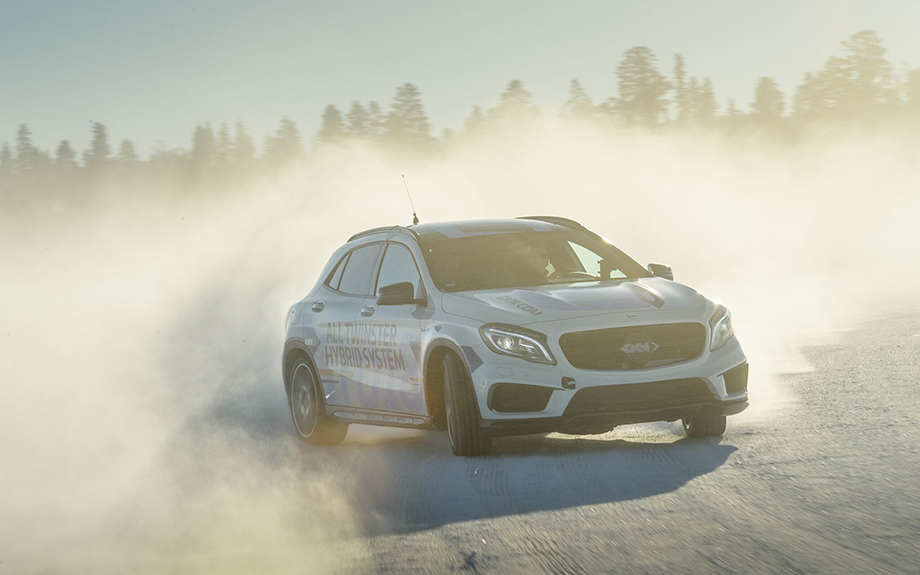- Re-engineered ‘technology demonstrator’ SUV features GKN’s unique Twinster torque vectoring on all four wheels
- Modified Mercedes-AMG GLA 45 has mechanical Twinster on front axle and eTwinsterX at the rear
- Demonstrator showcases the company’s leadership in eDrive, All-Wheel Drive and systems integration
- Plug-in hybrid has ‘sailing’ capability to lower CO2 emissions and also features a pure EV mode
Redditch, UK, 28 February 2018: GKN Driveline has begun testing a revolutionary SUV technology research vehicle, which showcases its leadership in electrified drivetrains, All-Wheel Drive (AWD) and systems integration. Based on a Mercedes-AMG GLA 45, the one-off GKN Technology Demonstrator 2018 vehicle (GTD18), features mechanical and electric Twinster torque vectoring, a plug-in hybrid system and completely re-engineered control systems.
GKN’s substantial re-engineering of the standard road car means that the petrol-powered SUV with hang-on AWD ‘torque on demand’ functionality has become a petrol-electric plug-in hybrid with a zero-emissions pure-electric drive mode, and axle-split eAWD functionality that is independent of the combustion engine. Torque vectoring by GKN’s award-winning Twinster system is available on all four wheels, which is a world first.
Following initial testing at GKN Driveline’s Lohmar R&D centre in Germany, the GTD18 begins more extensive validation and proof-of-concept demonstrations this month at the company’s Wintertest facility in northern Sweden. This year marks the 30th anniversary since GKN first started testing and demonstrating technologies at its dedicated vehicle development facility just outside the Arctic Circle.
Unique ‘All Twinster’ driveline
For the front axle drive, GKN’s technical showcase harnesses the donor car’s 280 kW (381 PS) four-cylinder powertrain, and integrates a mechanical Twinster unit directly to the gearbox, replacing the final drive and differential. This allows GKN’s software to have complete control of torque distribution through the unique twin-clutch system that can make rapid and precise adjustments between the front left and right wheels by application of torque vectoring.
As part of the complete tear-down of the brand-new donor vehicle, the front Power Transfer Unit, propshaft and rear axle were all removed. In their place, at the rear of the car, GKN has integrated its new two-speed eAxle – ‘eTwinsterX’ and a high-performance battery. Despite a high output of 120 kW (163 PS) and 210 Nm (155 lb ft) of torque, the integrated e-motor’s coaxial format means that the electric drive (eDrive) unit is significantly smaller than other systems with equivalent power outputs. This allows it to easily integrate within existing vehicle platforms, providing ‘bolt on’ eAWD hybridisation. The eTwinsterX system also features a GKN-designed two-speed transmission, as well as full torque vectoring capability.
The unique ‘All Twinster Hybrid System’ setup of the demonstrator car means that GKN can precisely control the distribution of torque to all four wheels. New electronic control units (ECUs) were installed to govern the dynamics of the one-of-a-kind driveline, and all software was developed and calibrated by GKN engineers. This also extended to the integration of GKN’s hardware and software with the standard car’s systems, to ensure that the electric drive at the rear runs in harmony with the petrol powertrain at the front.
New dynamics and efficiency
GKN’s eTwinsterX system gives the GTD18 an extraordinary level of agility, with unprecedented all-wheel torque vectoring capabilities, including the capability to over-speed the outside wheel in a corner to induce a yaw moment, helping to bring the car into a tighter line when turning.
The transformation of the GLA45 from an all-wheel-drive internal combustion engine-powered car to a technology demonstrator, incorporating a number of distinct drive modes, showcases GKN’s extensive capabilities in complex and sophisticated vehicle integration.
The driving modes – which are switchable ‘on-the-fly’ – can be selected via a touch pad inside the car. The eTwinsterX system allows for a pure-electric, zero-emissions drive mode through the rear wheels. Conversely it can also operate in solely front-wheel drive mode. The combination of the two delivers a hybrid eAWD mode with the two powertrains working together.
Re-engineered with 1,340 new parts
The build involved significant re-engineering work. As well as relocating several components, new hardware was introduced, including a new bespoke rear subframe to integrate the eTwinsterX system, a new high-capacity battery under the rear seats, a new exhaust system, and new wiring looms. In addition, new ECUs were integrated with the existing Mercedes-AMG software control systems. In total, 99 assemblies needed significant mechanical or electrical modifications, resulting in 1,340 new parts being added to the vehicle.
Almost every piece of the new technology in the car is a functional sample or an early-stage prototype, so GKN created several hardware-in-loop (HIL) sub-systems in parallel, to identify and solve any installation and integration issues in the car.
50 years of advanced technology demonstrators
The GTD18 – featuring its unique “All Twinster Hybrid System” – is the latest in a series of vehicles that act as a showcase for the company’s advanced driveline technologies. In 1968, GKN-Vandervell unveiled a special demonstrator based on an elongated Lotus 47 Europa chassis and fitted with a 3.5-litre Rover V8 engine. The engine itself used a raft of GKN components, and the company fully upgraded the driveline using its latest high-grade CV Joints. It had a top speed of 162mph and could accelerate from 0-60mph in 5.0 seconds. In recent years, the car has been fully restored and resides in the US.
In 1971, GKN built another remarkable ‘test bed’ for its products, modifying a Jensen Interceptor FF with a custom body designed by Williams Towns. The car was powered by a bespoke 7.0-litre V8 engine, featuring upgraded GKN-Vandervell bearings, and producing 600 bhp. At the time, GKN held the manufacturing rights to the Ferguson Formula (FF) four-wheel drive system, and so also used the car to demonstrate its capabilities in driveshafts, CV Joints and power transfer units with its latest product lines. During a record run at the MIRA proving ground in 1972, GKN's FFF100 ran 0-100-0mph in 12.2 seconds in the rain. Its dry-run record of 11.5 seconds stood until it was broken by the McLaren F1.
GKN’s global leadership in eDrive and AWD systems today owes much to the integration of advanced driveline technologies into experimental demonstrator vehicles, many of which have been subjected to intensive testing at its Wintertest facilities in Sweden over the last three decades. In recent years, a modified Volvo XC90 was created as a ‘test bed’ for the single-speed eTwinster system, while a BMW M3 saloon has been taken apart by GKN engineers to replace its conventional rear differential with a mechanical Twinster unit – the first setup that shows the benefits of twin-clutch torque vectoring and ‘true’ sailing functionality in a purely rear-wheel drive vehicle.



